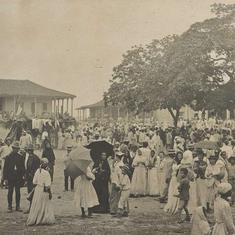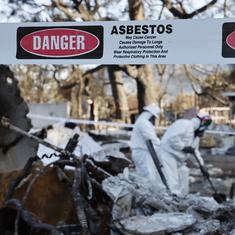While leaders gather at the COP27 UN climate summit in Egypt to address how to stem global warming, a handful of officials are working on the ground to tackle the effects of extreme heat in cities around the world after taking a role that did not exist until last year: chief heat officer.
From heatwaves in Athens, Greece, to drought in Mexico’s Monterrey, chief heat officers are trying to ease the impacts of hotter, more dangerous summers that threaten the health and livelihoods of billions of urban residents.
The position was created through an initiative by the US-based Adrienne Arsht-Rockefeller Foundation Resilience Center (Arsht-Rock) at the Atlantic Council think-tank, starting with the appointment of the world’s first chief heat officer in Florida’s Miami-Dade County in April 2021.
The group has since grown to eight heat officers, all who happen to be women, focused on protecting vulnerable residents – mainly women, the elderly and low-income communities – from rising temperatures.
“This is not just happening in one city,” said Eugenia Kargbo, Africa’s first chief heat officer, who was appointed in Sierra Leone’s capital, Freetown, in 2021, as part of the Arsht-Rock project.
“And it’s not just affecting women. But we mostly focus on supporting the most vulnerable and, in our case, women are the most vulnerable,” she said in an interview.
In Europe alone, at least 15,000 people have died because of hot weather in 2022 so far, according to data published this week by the World Health Organization.
By 2050, heatwaves will affect more than 3.5 billion people globally – half of them in urban centres – as they grow in frequency, duration, and intensity, according to Arsht-Rock.
Health experts say this means billions of people are at risk of preventable death and illness from exposure to extreme heat, which can result in heat stroke or kidney failure and exacerbate heart or respiratory diseases, among other health problems.

‘Silently dying’
Climate change is amplifying the “heat island effect,” where urban areas are often several degrees warmer than nearby rural areas as materials prevalent in cities – like concrete and metal – absorb and later radiate heat, scientists say.
Today, more than 350 cities experience summer temperature highs of over 35 degrees Celsius (95 degrees Fahrenheit) – by 2050, about 970 cities will be at least that hot during the summer, according to the C40 Cities network of major cities working to slow climate change.
In Freetown, home to more than one million people, residents are “silently dying” from extreme heat, said Kargbo.
Spending most of their time outside with little shade, Freetown’s market traders are among the most vulnerable to the impacts of rising temperatures – and most of them are women, she noted.
“Women are exposed to the health risks but also the economic risk of extreme heat because most of what they are selling are vegetables and fruit, which when exposed to the sun spoil easily,” Kargbo said.
Kargbo said she is co-designing a project with market traders in three of Freetown’s largest street markets to install heat-reflective panels to provide shade cover, directly benefiting about 2,000 women.
She is also leading a heat-mapping initiative ahead of Sierra Leone’s driest and hottest season starting in January, to collect data that will help her team and local officials picture the impact that the invisible threat has on urban residents.

Protecting the poorest
In the industrial city of Monterrey, in North Mexico, Surella Segú is also on a mission to raise awareness among the city’s five million residents about the dangers of extreme heat.
Residents got a wake-up call in June and July, when they grappled with a severe drought that caused record water shortages, said Segú, who was appointed Monterrey’s chief heat officer in April.
“People are saying, ‘Well, it’s just another hot summer.’ But the reality is that every year it’s getting hotter and hotter,” she said in a phone interview.
About 70% of Monterrey is experiencing the heat island effect, said Segú, noting that a lack of green public spaces and parks, especially in low-income neighborhoods with homes that often do not have air-conditioning, means the city’s poorest are the most exposed to extreme heat.
An architect and urban planner, Segú is working on plans to build city parks and green corridors to help cool public spaces and is also pushing for improvements to the city’s water management systems, such as groundwater recharging supplies and water harvesting, to prevent water shortages.
For those projects to succeed, the city needs to convince residents of the importance of changing the way they live, she said, such as using less water and driving less to help bring down air pollution levels, which are exacerbated by high temperatures.
“Unless we change the culture, we are not going to really be able to transform the city...it’s going to take time,” Segú said.
Ranking heatwaves
Eleni Myrivili, who became chief heat officer for Athens last year, said the combination of a string of heatwaves and recent wildfires near Greece’s capital this year brought attention to the issue of extreme heat.
During heatwaves, residents stay indoors, leading to economic strain for local businesses from lost earnings and the drop in productivity, said Myrivili.
“When it’s very hot, cities empty out...they become more like ghost towns and people retreat into their houses and this is how heat impacts economies in cities, because there’s less commerce,” said Myrivili.
And while heatwaves are one of the biggest climate-related threats to human health, they rarely receive the same attention as more visibly devastating disasters, such as hurricanes, partly because heatwaves are not named or ranked, climate experts say.
Arsht-Rock recently launched the Extreme Heat Resilience Alliance, which brings together global experts and scientists – from groups such as the National Oceanic and Atmospheric Administration and the World Meteorological Organization – to build a standard practice for naming and ranking heatwaves.
In July, Spain’s city of Seville became the first in the world to name a severe heatwave - Heatwave Zoe - as daytime temperatures soared above 42 degrees Celsius.
Last year, Myrivili worked with Greek meteorologists and the Red Cross to spearhead a similar pilot project in Athens to rank heatwaves from Category one to Category three.
This allows citizens to take precautions, like staying indoors, and outdoors sports events to be canceled, helping the most vulnerable groups – such as migrants, pregnant and breastfeeding women and the elderly – to stay safe, said Myrivili.
Meteorologists have created an algorithm to forecast the next heatwave and categorise it according to how dangerous it could be to human health, she said.
“We will keep on using this. We really believe this is a game changer...(that will) become part of how people understand the different types of heat,” Myrivili said.
This article first appeared on Context, powered by the Thomson Reuters Foundation.










